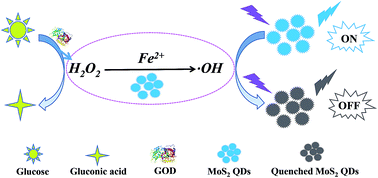MoS2 QDs co-catalytic Fenton reaction for highly sensitive photoluminescence sensing of H2O2 and glucose†
Abstract
Photoluminescence probes based on a conventional Fenton system show unsatisfactory sensitivity due to low H2O2 decomposition efficiency. Herein, we report that molybdenum disulfide quantum dots (MoS2 QDs) show excellent co-catalytic activity for Fenton reactions due to the Mo4+ active sites on their surfaces facilitating Fe(III)/Fe(II) cycle reactions and high H2O2 decomposition efficiency. The MoS2 QDs were prepared by a simple hydrothermal method, and the obtained MoS2 QDs showed blue fluorescence with a high quantum yield of 13.4%, storage stability, and excellent water-solubility. By using bifunctional MoS2 QDs acting as both the fluorescent probe and the Fenton catalyst, a MoS2 QDs co-catalytic Fenton sensor system was proposed for ultrasensitive and selective fluorescence sensing of H2O2 with a linear range from 0.01 to 20 μM and a detection limit of 5 nM (S/N = 3). When coupled with glucose oxidase, glucose can be detected in the range of 0.01–30 μM with a detection limit of 7 nM. Moreover, we successfully demonstrated the potential application of the proposed system for glucose sensing in actual biological samples. The novel strategy proposed in this work may open a new window of interest in an unconventional application of MoS2 QDs-Fenton sensor platform for environmental and biological applications.

- This article is part of the themed collection: Analytical Methods Recent HOT articles


 Please wait while we load your content...
Please wait while we load your content...